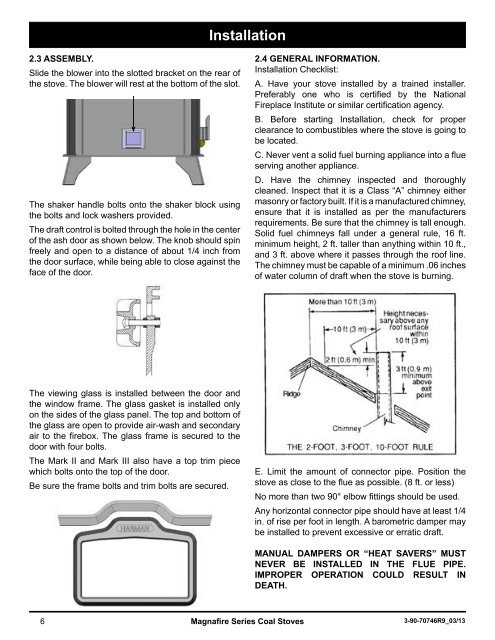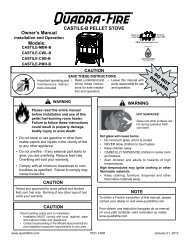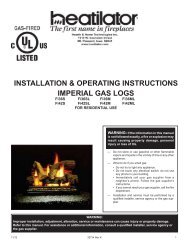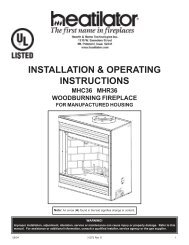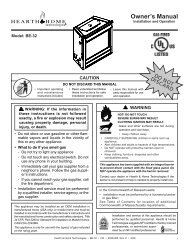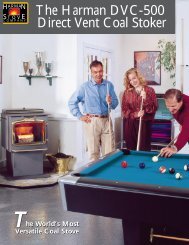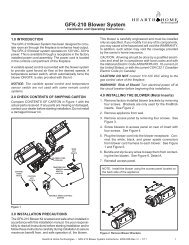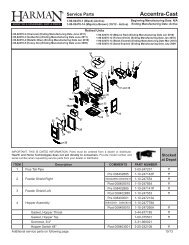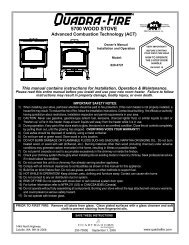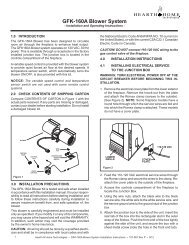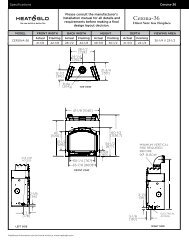Installation and Operating Manual Magnafire Series Coal Stoves ...
Installation and Operating Manual Magnafire Series Coal Stoves ...
Installation and Operating Manual Magnafire Series Coal Stoves ...
Create successful ePaper yourself
Turn your PDF publications into a flip-book with our unique Google optimized e-Paper software.
2.3 ASSEMBLY.<br />
Slide the blower into the slotted bracket on the rear of<br />
the stove. The blower will rest at the bottom of the slot.<br />
The shaker h<strong>and</strong>le bolts onto the shaker block using<br />
the bolts <strong>and</strong> lock washers provided.<br />
The draft control is bolted through the hole in the center<br />
of the ash door as shown below. The knob should spin<br />
freely <strong>and</strong> open to a distance of about 1/4 inch from<br />
the door surface, while being able to close against the<br />
face of the door.<br />
The viewing glass is installed between the door <strong>and</strong><br />
the window frame. The glass gasket is installed only<br />
on the sides of the glass panel. The top <strong>and</strong> bottom of<br />
the glass are open to provide air-wash <strong>and</strong> secondary<br />
air to the firebox. The glass frame is secured to the<br />
door with four bolts.<br />
The Mark II <strong>and</strong> Mark III also have a top trim piece<br />
which bolts onto the top of the door.<br />
be sure the frame bolts <strong>and</strong> trim bolts are secured.<br />
6<br />
<strong>Installation</strong><br />
<strong>Magnafire</strong> <strong>Series</strong> <strong>Coal</strong> <strong>Stoves</strong><br />
2.4 GENERAL INFORMATION.<br />
<strong>Installation</strong> Checklist:<br />
a. Have your stove installed by a trained installer.<br />
Preferably one who is certified by the National<br />
Fireplace Institute or similar certification agency.<br />
b. before starting <strong>Installation</strong>, check for proper<br />
clearance to combustibles where the stove is going to<br />
be located.<br />
C. Never vent a solid fuel burning appliance into a flue<br />
serving another appliance.<br />
d. Have the chimney inspected <strong>and</strong> thoroughly<br />
cleaned. Inspect that it is a Class “a” chimney either<br />
masonry or factory built. If it is a manufactured chimney,<br />
ensure that it is installed as per the manufacturers<br />
requirements. be sure that the chimney is tall enough.<br />
Solid fuel chimneys fall under a general rule, 16 ft.<br />
minimum height, 2 ft. taller than anything within 10 ft.,<br />
<strong>and</strong> 3 ft. above where it passes through the roof line.<br />
The chimney must be capable of a minimum .06 inches<br />
of water column of draft when the stove is burning.<br />
e. limit the amount of connector pipe. Position the<br />
stove as close to the flue as possible. (8 ft. or less)<br />
No more than two 90° elbow fittings should be used.<br />
any horizontal connector pipe should have at least 1/4<br />
in. of rise per foot in length. a barometric damper may<br />
be installed to prevent excessive or erratic draft.<br />
MANUAL DAMPERS OR “HEAT SAVERS” MUST<br />
NEVER BE INSTALLED IN THE FLUE PIPE.<br />
IMPROPER OPERATION COULD RESULT IN<br />
DEATH.<br />
3-90-70746R9_03/13


